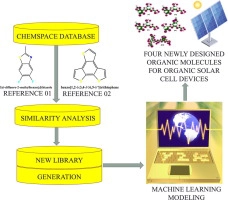Search of electron-rich and electron-deficient building blocks through data mining and library generation for the designing of polymers for organic solar cells

Typical designing of the organic molecules for numerous chemical, biochemical, and electrochemical applications requires extensive human workforce, conceptual intuition, far-reaching academic literature survey, and laborious experimentation. Recently, data-driven approaches, peculiarly machine learning (ML) analysis, have emerged as an alternative methodology to these traditional designing methods. These ML approaches provide robust and quicker way to address the serious restrictions of unavailability of work space, painstaking experimentation, and reduction in the number of experimental trials. In present study, two reference compounds, 5,6-difluoro-2-methylbenzo [d] thiazole and benzo [1,2-b: 3,4-b': 6,5-b''] trithiophene were selected as standard reference compounds. The ChemSpace database was mined for screening the potential effective building blocks and the new libraries of the organic molecules (having high similarity correlation with the reference compounds) were generated for designing the organic solar cell (OSC) devices. The ML analysis was also performed to predict the reorganization energy. The newly designed molecules were further evaluated with respect to their synthetic viability and electronic distribution characteristics to computationally excess the applicability of these novel organic molecules for the OSCs devices. The work presented in this study provides an alternative methodology for the selection of novel organic molecules for developing high-performance OSCs devices.
Publisher URL: https://www.sciencedirect.com/science/article/pii/S1010603023008134
DOI: 10.1016/j.jphotochem.2023.115348
Keeping up-to-date with research can feel impossible, with papers being published faster than you'll ever be able to read them. That's where Researcher comes in: we're simplifying discovery and making important discussions happen. With over 19,000 sources, including peer-reviewed journals, preprints, blogs, universities, podcasts and Live events across 10 research areas, you'll never miss what's important to you. It's like social media, but better. Oh, and we should mention - it's free.
Researcher displays publicly available abstracts and doesn’t host any full article content. If the content is open access, we will direct clicks from the abstracts to the publisher website and display the PDF copy on our platform. Clicks to view the full text will be directed to the publisher website, where only users with subscriptions or access through their institution are able to view the full article.


